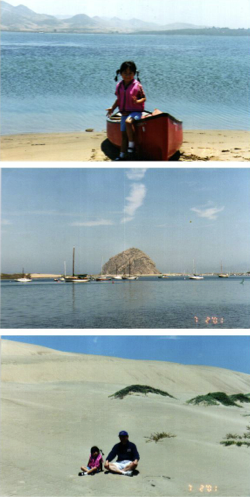San Luis Obispo - 沙洲過客

Laguna Lake
Driving there, down 101 from San Jose, it was surprisingly easy and quick, just about three and half hours. After a quick late lunch, there was plenty of daylight as well as energy left for the day. We dipped in the hotel pool, a must for our four-year old. We took a walk along the Laguna Lake Park just across the street from the Embassy Suits where we were staying. We flew a kite and ran around in the playground adjacent the lake. Simple houses line the shore opposite the park, each with a boat tied to its dock. Geese and ganders swam in V-shape in the lake. Wild turkeys hid away in bushes along the lake. Smoke and aroma from the BBQ stalls in the park snaked up the sky and found its way to our noses. The leisure pace all around us sure reminded us that we were on vacation.Morro Bay
The next morning, we set off for Morro Bay, heading for the Museum of Natural History in Morro Bay State Park. The museum sits on the cliff and has great vantage point over the bay. From there, we saw dozens of kayaks and canoes dotting the green bay beneath us and the bay as calm as a lake. A long stretching sand dune peninsula banks the outer side of the bay separating out the Pacific Ocean. I am a novice at rowing but the bay water seemed smooth enough for even me to handle. We decided to try canoeing.We rowed our rented canoe out from the state park dock at noontime heading for the sand dune straight across. For 40 minutes we rowed toward the sand dune shore, skating occasionally on top of patches of seaweed. The shore seemed so close yet so hard to get to. At last, we were on the shore. There was no one in sight but footprints leading over the towering sand dunes. We trod up the sand dune and the Pacific Ocean spread just beyond. Few swimmers and gulls were chasing the white foams retrieving from the beach and the famous Morro Rock stands at the mouth of the bay. Looking toward inland, sister rocks of Morro Rock top the green hills by the coast. We did not linger long in anticipation for the tough rowing back. It turned out that the rowing back to the dock was a breeze with the wind on our back. The outing gave us a good workout and we worked up a good appetite for our lunch.
The state park itself is a sanctuary for birds. Gulls and a lone falcon glided overhead, a few pelicans perched and bobbed on top of buoys, here and there wild ducks floated in the bay and black birds chirp away in the trees. Sea breezes and tall eucalyptus trees cooled the trail by the shore even in high noon when the sun was blazing away. A heat wave was passing through the state but we hardly felt it in this coastal hideaway.
The next day, we hadn't planned to go back to Morro Bay but my husband left our camera and binocular on the boat dock so we had to go back. Since we were there, we went canoeing again, this time a little deeper into the bay. We brought lunch and intended to stay out a little longer. After we rowed ashore across the bay, we trod up one sand dune but another lied beyond. We trod and trod but could not see the white waves or the ocean. Where we landed the width of the sand dune peninsular was much fatter and we had underestimated the effort it took to climb over it. All around us the sand dunes stacked up over us with no end in sight. We were exhausted and could easily imagined what the dessert must be like and what it felt to be lost in one, except we still had the cool breeze to comfort us. Exhausted and hungry, we decided to have our lunch right then and there. After lunch and a little rest, we had our strength back. Just a few steps further, we saw the ocean and the waves. We were the only people on a long stretch of beach with seagulls feeding off what the tides brought in keeping us company. We must have stayed out quite a long time, for when we set out the tide was high but when we rowed in, we nearly got stranded on the shallow seaweed patches several times before we finally got back to the dock.